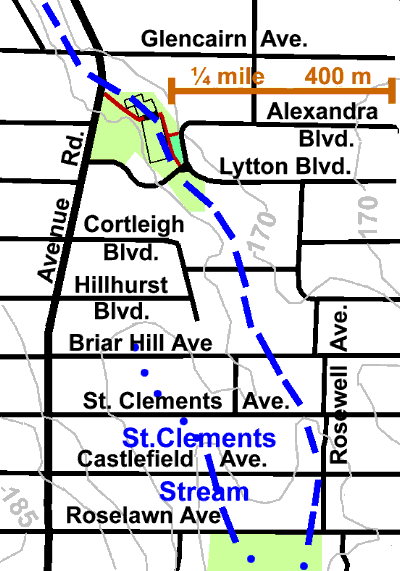0.8 km of Mud Creek from Avenue Road to Roselawn Avenue, including the tributary, St. Clements Stream, 0.5 km.
This area of large residential homes was originally in the former Town of North Toronto. Two small parks, Lytton Park and Begg’s Garden lie along the valley of Mud Creek. While most storm water has been diverted to Burke Brook in Sherwood Park, some flows to Yellow Creek via Eglinton Park. Sanitary sewage flows, via the Avenue Manor Combined Trunk Sewer, to the North Toronto Sewage Treatment Plant in the Don Valley.
The walk begins at Avenue Road south of Glencairn where a set of steps lead down into the valley and Lytton Park. Trees noted in this park included: a large white ash, linden, silver, sugar and Norway maples, honey locust, elms, walnut and red oak. Walk past the tennis courts and lawn bowling greens to Lytton Blvd. Note the North Toronto Green Community’s restoration project on the slope up to Alexandra Blvd. In particular note the woodland sunflowers and asters as well as the planted trees which include white pine among others.
The tennis courts at Lytton Park lie directly over the original ravine bed. In winter the courts have been used as skating rinks. Edward Stockdale, General Manager of the Trusts and Guarantees Co, started the Lytton Park Lawn Bowling Club. In 1910, he subdivided his lot to create Lytton, Alexandra and Strathallan Boulevards, while setting aside the ravine areas on both sides of Lytton Blvd. The north part became a lawn bowling club, and the south a private garden with Mud Creek passing under a bridge on Lytton Blvd. In 1921, Mr. Stockdale moved to #184 Alexandra Blvd.
Click here to see sewers. Double click to remove.

From the the ravine shape in Lytton Park, it is easy to imagine the ponds which formed here. Indeed this description excellently captures the characteristics of a stream during the early stages of urbanization: increased flooding and run-off and probably increased but erratic flow throughout the year. Ultimately the creek was completely buried, replaced at first by the Avenue Manor Combined Sewer. It follows the whole course of the river from here to Balliol Street, a little north of Mount Pleasant Cemetery. Over time this has been supplemented by several storm sewers. See Memories of Mud Creek.
Across Lytton Blvd. is a small park called Begg’s Garden, a sunken spot of grass surrounded by trees such as sugar, silver and Norway maples, elms, Colorado spruce, honey locust, juniper and a large ailanthus. A plaque in the center of this park explains that the garden was a donation to the city in memory of Mr. Herbert Begg by his daughters.
Mr. Begg was director of several insurance companies, President and Managing Director of Shaw and Begg Insurance Managers, and later Chairman of Edward Stockdale’s company. He built 205 Lytton Blvd. in 1923 and in 1928 he bought the reserve land to the south of Lytton Blvd. and created this sunken garden, using Mud Creek as the source of water. Tour Busses would stop to view this garden and the CBC filmed “A Doll’s House” here.
Behind the wrought iron fence at the south end of Begg’s Garden lies a part of the ravine belonging to Mrs. Fischer. During the 1980’s, Mrs. Fischer was host to one of the first community gardens in Toronto. Today, the form of the beds can be seen below the thick growth of Manitoba and Norway maples which has grown since then. Her backyard is home to red foxes, mallard ducks and several typical deciduous forest trees: black walnut, black cherry, sugar maple, hemlock, and some heritage fruit trees from an old orchard. In the spring, trilliums and trout lilies are seen.
Click to see how one resident of this area marked the course of Mud Creek through his garden.
Return to the street and walk east on Lytton Blvd. to Rosewell Ave. Just east of the ravine is #181 Lytton Blvd., built in 1911 for a sculptor named Gordon Osborne. to the This house has been expanded several times, but always in a style true to the original “Cotswold Cottage” with an asymmetrical plan, steep roof, leaded casement windows, and half timbering. Note also #151 Lytton Blvd., built in the Elizabethan Revival style so popular in the Toronto of the 1920s and 30’s. #138 Lytton is built in an “interesting” industrial style.
Turn south at Rosewell Ave., which meanders along the east bank of the ravine a classic example of the influence of natural features on the form of city streets. The houses on the west side of the street all have backyards which lie in the ravine itself. You will be able to see the approximate path of the creek by looking west on each cross street to find the lowest point in the road. Observe that the houses built at the low points are all much newer than the houses on higher ground. Low damp ground overlooked in earlier housing development is now a source of sites for infill housing. If you were to walk west on Cortleigh you could listen to the rushing of water under the sewer grate in front of one of these infill houses. The house on the north side of the street lies at the back of Mrs. Fischer’s ravine, and is directly on the path of Mud Creek.
Notice the two dips visible to the west along both Briarhill and St. Clements. The first and deepest dip marks the course of Mud Creek. The second, at a slightly higher elevation, is the valley of a tributary here called St. Clements Stream.
Between St. Clements and Castlefield Avenue, Rosewell appears to be over the former course of the stream. Trees along Rosewell include Norway, silver and sugar maples, honey locust, Austrian pine, elm, European larch, and Colorado spruce. At the south end of Rosewell enter Eglinton Park and Eglinton Park Reach.
